#hariza
Text
Wanna taste Koufia venom?!

My part of the art trade with the unspeakably cool @alenchikova
Her gorgeous OC Hariza Varrani. It was super fun to draw her.
Seriously, check out her stuff, she writes and draws great things. The fandom needs more people like that.
9 notes
·
View notes
Text
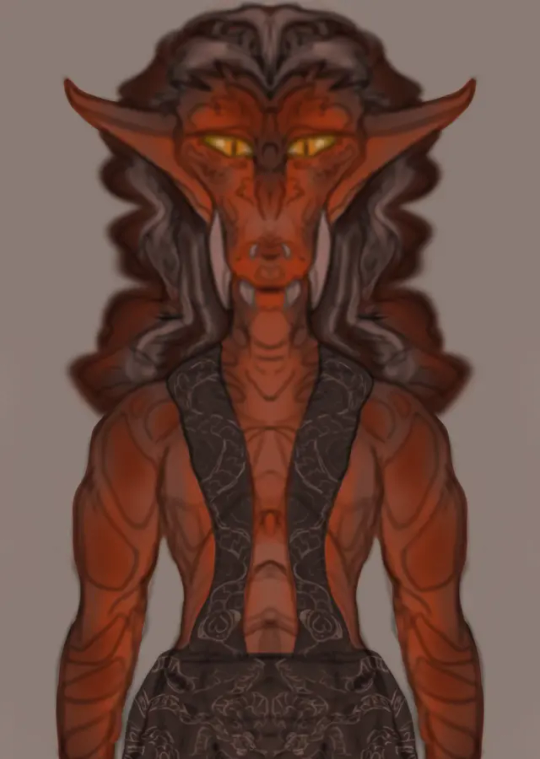



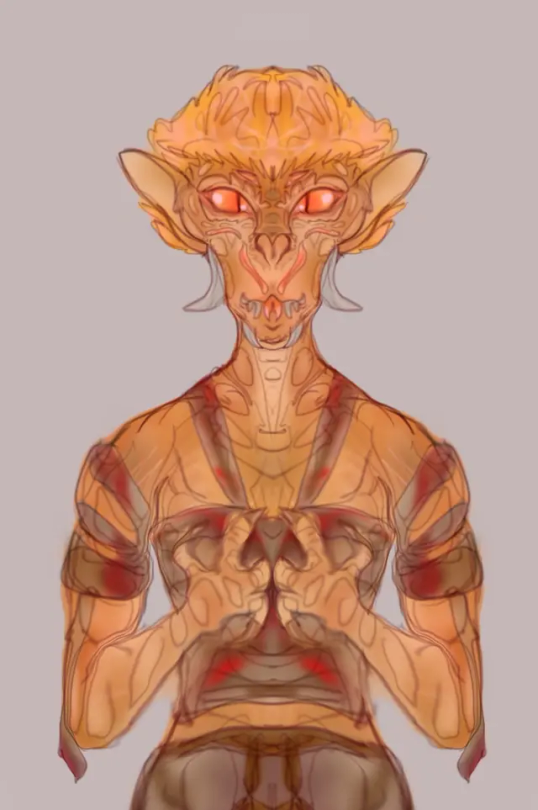
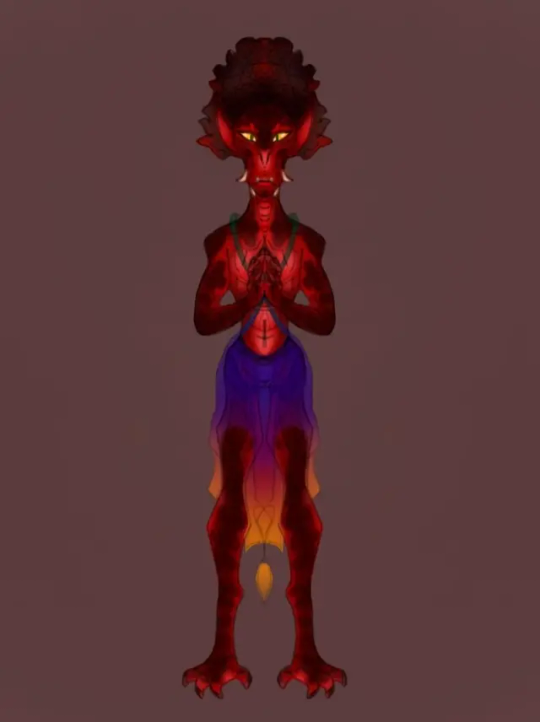

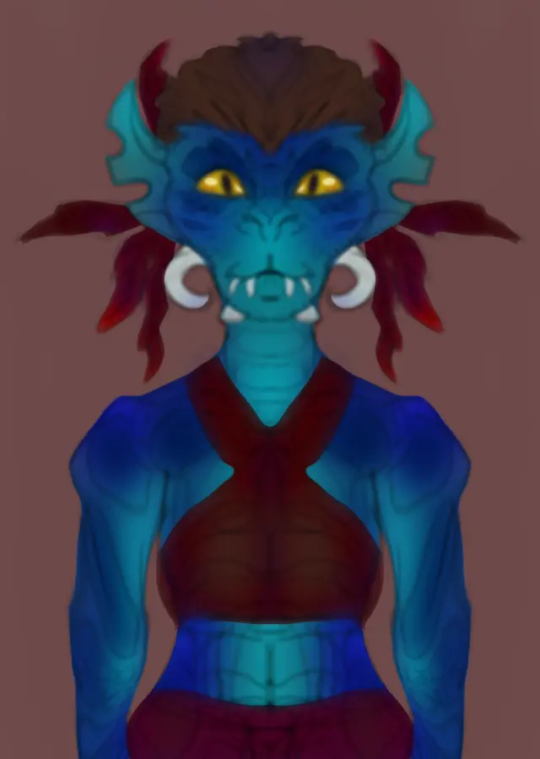


Slightly redoing GenGrievous wives
Aaand i'm here to tell somthing about 'em heh
Grievous' wives:
1. Lediva jai ShekShee - First wife, older than Grievous by 10 years. A woman of unhappy life and destiny. Collected and calm, does not panic in dire situations. She was responsible for the quick and efficient evacuation of her clan to the mountains, where the Hacks would not go. But despite this, she was unable to save her daughter from the clutches of the enemy. Lediva is quite harsh in her character, after losing her child she became even more harsh and unsettled. Eventually left the clan, becoming a mercenary. She joined the growing Grievous Khaganate. Lediva was good at logistics, for which she was noticed by Grievous. Over time, the two became close. Lediva has two children with Grievous. The fate of her first daughter is unknown.
2. Sangarta lij Rakkash is the second wife already of Grievous. Tribal Khan from the Grendaju territory (where Ronderu is from). She killed her mother (the past Khan, leading the tribe to death because of her submission to the Hakam, in a battle for the right to rule the tribe). Her marriage to Grievous was originally a marriage of convenience, with Sangarta receiving military and guianitarian support and Grievous himself a political and military ally. Three children by Grievous.
3. Izurr jai Nari'i is bright, talkative and easy-going. She can make anyone feel at ease. She was the first to find common ground with the withdrawn and traumatised Rarek. Originally just one of the many steppe Kalisha who had joined their tribes and families to Grievous. Izurr had no idea what Grievous looked like without his mask and customary Khagan robes, and was very surprised to find out who she interacted with so nicely and often. In one of their meetings, Grievous said that Izurr looked like Ronderu to him. He took offence at this, saying that he saw her as a long dead friend rather than Izurr herself. They got into a fight, but Izurr was the first to make up, because she's emotional and hot-tempered. at times, but she's also resilient. This moment took their relationship to a new, much more trusting and intimate level. Four children by Grievous. Isurr loves children, as she grew up in a large and close-knit family.
4. Mikir Inariuz is mistrustful, stubborn and harsh, and does not get along well with people. Her family was killed by the Huks, only Mikir and her younger brother escaped. She blames herself for the death of her family and hates herself for her weakness (she fled with her brother rather than stay to protect her tribe and family; she was 15 full years old at the time of their deaths), her brother will later become her right-hand man. Head of a small mercenary clan. At the time of her meeting with Grievous, she was working under the Khan Irrijar. Her relationship with Grievous began a few years after they met. Mikir has three children with Grievous. Before that, there were two aborted pregnancies and three children by him who died giving birth. This finally broke her completely. Mikir is very hyper-patient with her children and those close to her because of her fear of loss. Takes it upon herself to take care of all the clan members to feel useful and cope with the pain of loss.
5. Rigraz san Marrak - born as jai Emezzez. She is the adopted daughter of Ursaddi san Marrak. Rigraz tries not to remember her birth father. Rigraz's mother died of dystocia (folliculostasis, in simple language - obstruction of the oviducts, as a consequence of necrosis and death) after the birth of her only daughter, and Rigraz's father was disturbed by grief. He sincerely believed that the albino girl was responsible for her mother's death and other misfortunes, that she was cursed. He tried to "cure" the curse by abusing the child in every possible way. For example, he carved the clan symbol of a passing Kalish into her face, convinced that this would drive the demons out of Rigraz. Once he sicced a mewmuu pup on her, Rigraz miraculously survived. His final atrocity was an attempt to burn his daughter alive, which was foiled by Ursaddi, who was passing by with his troop. Ursaddi adopted Rigraz, gave her his clan and territorial name, and did much to help the girl overcome and essentially forget her past life. In character, Rigraz is mean, rude, stubborn, and fierce. She first spotted Grievous as a potentially interesting man and began matchmaking with him out of boredom. Grievous accepted her advances. Rigraz often argues and vouchsafes with other wives, places no value on anyone else's seniority and pulls the blanket over herself. Has 5 children with Grievous, this was her first pregnancy. Surprisingly good and caring mother, very fiercely protective of her children and family. The only opinions she listens to are her non-blood father and Grievous.
6. Shimirrailu is a very spiritual and devout woman in a good way. A priest by work and vocation. Ever since she was a child, she has dreamed of becoming a Spiritual Leader. Her parents insisted that the girl undergo her initiation of her first hunt and learn how to handle various weapons. And afterwards, if she didn't change her mind, Shimirrailu would be free to become a Spiritual Leader or whatever. Shimirrailu is calm and patient in nature, but that doesn't mean you can lord it over her or disregard her opinions. Her meeting with Grievous took place during her losing battle against a superior Huk force. Shimirrailu has five children with Grievous.
7. Rarek Kresh is the protagonist in my works. Tough, harsh and cold. Shuns outsiders, but at the same time is very attached to her family, soft and kind to them. Sensitive to the Force, trained by her long dead ghost parents on both sides of the Force. Four years younger than Grievous, was married before him and had a child. Does not know or have met any living blood relatives. At the time she met Grievous, she was a mercenary. No children in common. Survived capture by the Huks and further slavery. Hailed as one of the most brutal pirate admirals of our time. Became involved in the Separatist movement after learning of a Kaleesh named Grievous. Hates the Sith for what they did to her family. Jedi too. Rarek is one of the most evil and crippled members of that family. Coming from a nomadic tribe.
8. Suanim san Deidarri - descendant of pirates settled on Kalee, hacker and head of a guerrilla group of former slaves, zanimpnym stealthy rescue of kin and pocketing hack equipment. She's led the Grievous Khaganate into major Huk bases several times. At one extremely difficult moment for her rebel cell (Suanim is not a professional hacker and "ice pick", as well as her squad are not special forces, they are quite few, no more than 200 people in total, and sooner or later more technically advanced hacks would have figured them out, which happened) Suanim came to Grievous with an offer that could not be refused - she offered to unite their forces for the war against a common enemy. Grievous agreed. Suanim worked with him a couple of years before Grievous married Rigraz and Shimirailu, but became his wife much later. In character, she is a cunning, wicked-eyed and very self-aware woman who will do anything for the well-being of those she considers her own. Three children by Grievous.
9. Hariza Varrani, a pirate by birth, ended up on Kali in a most incongruous way. Fleeing from another raid, she came out of hyperspace near Kalee, where Grievous's VCS forced her to land. The Khaganate needed ships for the war with the Huks, and how they would get those ships was immaterial. Hariza wasn't about to give away her honestly earned ship to someone unknown, but forces weren't on her side. So she made a risky but effective deal - she would give the ship to the Khaganate, but in return she would become Grievous' wife (she didn't like him, but the choice was to stay on a foreign planet surrounded by her war-ravaged kin or to become the wife of a strange but respected man who wasn't so bad, and retain the remnants of her independence and some integrity), and Hariza also demanded from Grievous the right to remain the pilot of her ship. Grievous agreed, putting a dozen more of his soldiers on the ship as crew. At first Hariza was not happy with her marriage of convenience, but later grew accustomed and attached to Grievous. She has four children with him. She'd grown roots in their not inconsiderable clan. Grievous called her Koufia, after the snake she resembled in colour. Or RiRi, which the rest of the tribe picked up on. After Martyr's death, Hariza had become her own shadow. Nothing left of the bright, puckish, and angry woman, she died with Grievous. Most of the day she just lay there staring at nothing, remembering the husband she once didn't even want to know. Hariza lived on inertia. One day she just didn't wake up, that night she dreamt of a living Grievous.
10. Mizir san Karraz is a homely, sweet and quiet girl. Mizir's family comes from the outskirts of Kaleela, the named capital of Kalee. Mizir is the eldest of 6 children of the family, very kind and caring, loving to babysit her siblings from a young age. She loves working with fabrics and various jewellery, making up and telling stories. Open and friendly, but also shy around those who seem to be the standard of a warrior. Mizir is extremely mediocre in combat, but that doesn't mean she is helpless or defenseless. Mizir, as well as her siblings, are brightly coloured and rare among Kaleesh, making them desirable prey for hacks. Not all Kaleesh have chosen to fight the invaders, some have chosen to sell their own kin to the Huks for wealth or their own lives. Mizir's parents hid their children in the forests where the Huks would not go. But one day they didn't make it, someone turned them in. Mizir did everything she could to keep her siblings hidden, diverting attention to herself, but she ended up falling into the clutches of the Huks. She was in slavery for a short time and didn't suffer physically (people like Mizir are rare and piece goods, the hacks make sure to keep them safe). She was pulled out, along with other lucky ones, by Grievous and his squad. Mizir was scared shitless and incredibly far from her home, Grievous brought her to his place, not knowing where to put a young, frightened woman unfit for war. Eventually, that's where she stayed, becoming his wife. Almost immediately she fell in love with Grievous. It is Mizir who is in charge of the household and food, helping the other wives with the children. Mizir is an excellent herbalist, and her skills have helped the family and the Kaganate many times when medical supplies have been interrupted. Mizir has one daughter by Grievous. She and her daughter have managed to keep the memory of Grievous and his not-dying-in-a-bacta-camera alive. By my headcanons, Grievous' wives and children had their memories of his survival erased to keep them out of the wrong places.
#kaleesh#my art <3#star wars#qymaen jai sheelal#калиш#general grievous#звездные войны#grievous#мой рисунок#моя работа#grievous' wives#lediva#sangarta#izurr#mikir#rigraz#shimirrailu#rarek#suanim#hariza#mizir
9 notes
·
View notes
Text




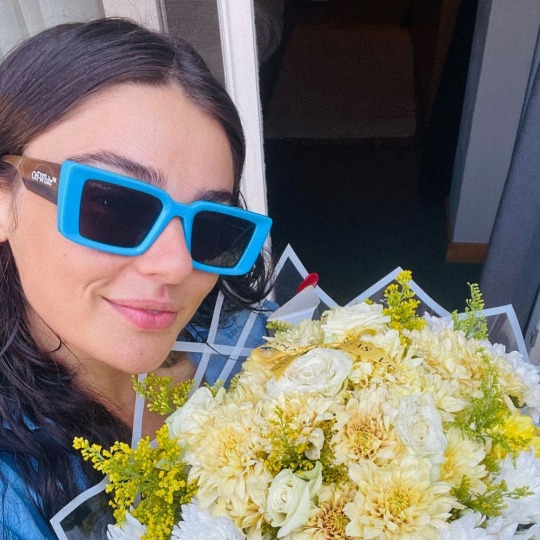
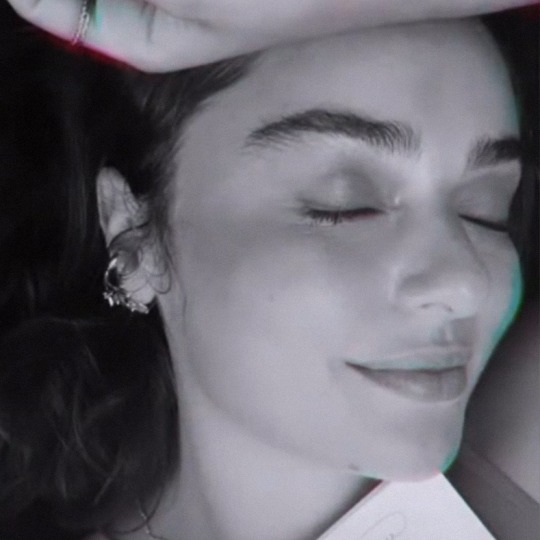
#ayca aysin turan#ayça ayşin turan#ayça aysin turan#ayça ayşin icons#meryem#ariza#zemheri#ada masalı#ada masali#hariza#kader bağları#sen inandir#random icons#turkish dizis#headers dizis#dizisi#turkish icons
11 notes
·
View notes
Text



HARIZA 🎸🕺✨
2 notes
·
View notes
Photo

30.1.2023 Didoakan Dtk @okktiting sentiasa sihat.. Kredit gambar @hariza https://www.instagram.com/p/CoDraPKBYtr/?igshid=NGJjMDIxMWI=
0 notes
Text
What's on your mind? (15)
So tumb, cerita ini tentang seseorang bernama Rakha Hariza (i like your name kha, really😂). Aku inget match sama dia waktu itu malam minggu, jam 2 pagi. Waktu aku desperate banget krn insom dan ga ada temen ngobrol. Krn lg desperate aku langsung chat dong haha. Nanya soal alisnya yang nyambung. Sebenernya basa basi banget tapi ternyata Rakha bales dengan jawaban super serius. Dari situ entah kenapa aku merasa bisa ngobrol banyak sama dia.
Dia juga baru bales besok siangnya kalo ga salah, dan langsung ngerasa klik dan ngobrolin segala macem. Yang biasanya aku pilih2 utk ngasih nomor hp, kali ini engga. Cuma chat sebentar di tinder dan langsung pindah ke wa. Cerita2 soal keluarga bahkan aku curhat soal Rega yg pas itu emang lagi agak renggang. Menarik cerita2 sama Rakha, i enjoy it. Terus hari itu, malamnya Rakha nelfon. Iya nelfon, dan aku mau aja ditelfon. Padahal aku gapernah suka ditelfon stranger. Terus Rega tau Rakha lg nelfon lalu dia insecure ahaha. Padahal pas rega nanya aku lg telfon siapa, ku lgsg bilang ke Rakha kalo pacarku nelfon.
Chat sama Rakha ga terlalu intens, tapi mostly ketika chat ada suatu hal yang membuatku merasa seneng aja gitu. Dia dan segala perhatiannya. Dia dan "aku izin ke sini yaa"-nya yang katanya biar ngga bikin aku nunggu dan khawatir. Awalnya aku pikir agak creepy sih mengingat dia bukan siapa2 gue juga gitu tapi somehow lama2 aku nikmatin gitu aja. Yang aku tau Rakha sibuk sama kerjaannya dan kuliahnya, walopun ga terlalu paham sibuknya sibuk apa. Dan akibat chatnya yg menyenangkan, kalo dia ngilang aku nungguin. Iya aku nungguin dan senyum2 aja gitu kalo ada chat dari dia. Kaya orang kasmaran. Padahal punya pacar.
Terus sampai sekali kita nyempetin videocall. Karena Rakha lg gabisa diganggu untuk ketemu, yaudah vcall aja. Itu vcall dari tengah malem sampe subuh. Aku lupa ngobrolin apa aja. Satu hal yang aku inget, tatapan matanya Rakha yang (ok mungkin aku kegeeran) penuh cinta (?) Hahaha. Aku gapernah dapet tatapan kaya gitu sebelumnya. Even itu cuma via videocall ya. Aku tersanjung dong digituin huhuhu. Aku lupa apakah Rega pernah natap aku kaya gitu apa engga. Mungkin dulu pernah. Gatau kalo sekarang😂
Abis vcall itu Rakha ngilang. Ngilang banget. Aku sampe khawatir ada hal yg aku salah omong sampai dia marah. Atau dia kenapa2. Dia bilang dia cuma stress aja. Ok aku kasih waktu. Dan aku kasih support. Aku pikir Rakha terlalu keras sama dirinya sendiri, sampai2 stres gitu. Terus aku cuma gamau sih dia gitu. Kasian lho badannya. Jadi aku tetep support supaya dia baikan.
Sampai pada akhirnya dia bilang dia sayang sama aku. Wow i'm overwhelmed😂😂 serius aku sampe degdegan hahaha. Trus aku mikir mikir mikir haduh apakah aku jg suka sama dia? Tapi aku kaya gamau suka sama dia krn aku gamau kehilangan Rega sedangkan sama Rakha jg gatau beneran suka apa penasaran doang. Trus aku confess ke dia, kubilang i think i love him but...
But-nya banyak. Since kita belum mengenal satu sama lain, dan posisiku yang punya Rega. Aku gamau gitu aja kehilangan Rega yg selalu ada buat aku. Gamau nyakitin dia (walopun udah). Gamau salah pilih (no offense kha, bukan maksudnya milih kamu itu salah). Aku cuma gamau gegabah sama perasaan. Lagipula aku udah engga mau nyoba2 sebuah hubungan. Aku gatau, bisa ajasih aku jodoh sama Rakha. Tapi untuk menuju ke sana pasti jalannya ga mudah. Dan aku cukup lelah mempertaruhkan perasaan😂
So here i am. Abis ketemu kemarin aku pikir ndak ada yg bisa menggantikan Rega dalam mengerti aku. Walopun aku masih takut ketika nanti aku "kambuh" dia bakal mutusin aku lagi. Masih takut ke depannya bakal banyak masalah lagi. Tapi kupikir kita udah sejauh ini dan aku gamau ngorbanin yg ada demi perasaan meletup2 yang engga tahu sebenarnya apa.
Buat Rakha, terima kasih untuk perasaannya buatku. Aku masih pengen sih kita temenan. Bisa ga sih perhatiannya sebagai temen aja😂 tapi di sisi lain aku takut terlena lagi. Satu sisi aku mikir ga ada yg salah sama yang namanya perasaan. Satu sisi lain aku mikir ga harusnya perasaan dimanja kalau ternyata itu nyakitin orang lain. Jadi yah gitulah. Aku bingung😂
Semoga bahagia selalu ya kha. Don't be so hard on yourself hehe. See you when i see you.
Jakarta, 21 November 2018
1 note
·
View note
Text
0 notes
Text
Petugas BPBD Sebut Identitas Korban Tenggelam di Pantai Padang, Seorang Bocah 10 Tahun Bernama Habib
Petugas BPBD Sebut Identitas Korban Tenggelam di Pantai Padang, Seorang Bocah 10 Tahun Bernama Habib
Laporan Wartawan TribunPadang.com, Rezi Azwar
TRIBUNPADANG.COM, PADANG – Petugas BPBD Kota Padang menyebutkan identitas korban yang hanyut merupakan bocah umur 10 tahun di Pantai Padang, Provinsi Sumatera Barat (Sumbar).
Petugas BPBD Kota Padang, Hariza Riko, menyebutkan kalau korban bernama Habib (10) warga Jalan Nipah, Kota Padang, Provinsi Sumbar.
Menurutnya, diperkirakan bocah tersebut…

View On WordPress
0 notes
Text
ISLAM 101: El Profeta Muhammad (PB): La Parte 27
¿Para qué son enviados los Profetas? : La Parte 2
Cuando la indiferencia de los idólatras de La Meca se convirtió en objeto de escarnio y luego en una persecución, tortura y boicot cada vez más insoportable, el Mensajero de Allah y Zayd Ibn Hariza fueron a Taif. Sin embargo, la gente de esa ciudad también les trató con severidad. Los niños se pusieron en fila a ambos lados del camino y les tiraron piedras. Como no tenían ninguna armadura, abandonaron la ciudad y encontraron un árbol para descansar bajo él. Sangraba profusamente. Levantó las manos y suplicó:
¡Señor Mío! Me quejo a Ti de mi debilidad, la carencia de recursos e importancia ante aquella gente. Eres el Más Misericordioso de los misericordiosos, el Señor del oprimido y el Señor mío. ¿A quién me abandonas, a aquel forastero que me mira con recelo y me hace muecas? ¿O a aquel enemigo a quien Tú has dado el dominio sobre mí? Si Tu indignación no es dirigida a mí, no tengo ninguna preocupación. Pero Tu gracia es mucho mejor para mí. Busco refugio en la luz de Tu Esencia, que alumbra toda la oscuridad y con la que los asuntos de esta vida y del Más Allá se han ordenado correctamente, no sea que Tu ira o Tu indignación desciendan sobre mí. Espero Tu perdón hasta que estés satisfecho. No hay ningún recurso o poder, sino el que Tú tienes.
Después de decir esto, notó que se le había ofrecido una bandeja. Un esclavo cristiano de Nineveh, Addas, había visto al Mensajero de Allah apedreado y ofendido desde la viña en la que trabajaba. Puso uvas sobre una bandeja y se las trajo a Muhammad. El Mensajero de Allah dijo “¡En el Nombre del Allah!” y empezó a comer. Esto sorprendió a Addas, ya que era la primera vez que él había oído esta frase entre los idólatras. Entonces preguntó al Mensajero de Allah quién era y por qué había venido a Taif. “Soy Muhammad, de La Meca, el Último Profeta”. Al oír la respuesta, dijo Addas con lágrimas en sus ojos: “Allah me ha hecho encontrarte” y abrazó el Islam.
El Profeta Muhammad se dedicó completamente a su misión. Por consiguiente, su halo de verdad se agrandó día a día, y el bando de la incredulidad estaba cada vez más frustrado: Quisieran apagar con sus bocas la Luz de Allah pero Allah rechaza todo lo que no sea completar Su luz, a despecho de los infieles(9:32). Cuando no había nada más que hacer en La Meca, emigró a Medina y siguió su misión allí. Aquí afrontó un problema diferente: las comunidades establecidas de judíos hostiles y, finalmente, una quinta columna de hipócritas que se aliarían con sus enemigos.
En el vigésimo-tercer año de su misión, sintió que su vida estaba a punto de terminar. Había realizado la peregrinación menor-la umra-algunas veces, pero nunca había podido hacer la peregrinación principal-el hayy-. Pudo hacerla durante este año final. Subiendo el Arafat en camello, predicó lo que se ha conocido como el discurso de Despedida. En él, puso énfasis en que las contiendas y las transacciones basadas en el interés fuesen prohibidas, y en explicar que las mujeres tenían también derechos, y habló de las obligaciones familiares así como de relaciones tribales y nacionales.
Una enorme congregación acongojada le escuchó. Mientras hablaba, les preguntaba con frecuencia si había comunicado apropiadamente el Mensaje de Allah. Con cada respuesta positiva, levantaba su dedo índice hacia el cielo y decía: “¡Oh Allah, Tú eres testigo!” Era consciente del Servicio Divino y podría haber pensado: “Allah me envió para cumplir la misión de la Profecía. Tal como esta gente ha atestiguado que cumplí con este deber, espero que pueda ser considerado como reminado realmente”. Estaba preparado para encontrarse con Allah con la entera satisfacción del deber cumplido.
Para ser ejemplos. Los profetas fueron enviados para servir como ejemplos que deben ser seguidos conscientemente. Después de hablar de los Profetas en la Sura al-An'am, Allah dijo a Su Último Mensajero: A éstos ha dirigido Allah. ¡Sigue, pues, Su dirección! (6:90). En particular, se nos ha conminado a seguir el ejemplo de Muhammad: En el Mensajero de Allah tenéis, ciertamente, un bello modelo para quien tiene en cuenta a Allah y al último Día y quien recuerda mucho al Todopoderoso (33:21).
El Mensajero de Allah es nuestro guía. Hacemos el salat como él lo hizo y debemos esforzarnos por vivir como él vivió. Aquellos que lo siguieron durante el primer siglo del Islam fueron verdaderos representantes de la autentica vida islámica. El Mensajero de Allah dice sobre ellos:
Después de mí, los ejércitos musulmanes llegarán a las puertas de las ciudades. Les preguntarán: “¿Ha visto alguno de vosotros al Profeta alguna vez?” Los musulmanes responderán afirmativamente y las puertas se les abrirán. Aquellos que los suceden también realizarán el yihad y les preguntarán: “¿Ha visto alguno de vosotros a los que vieron al Profeta?” Ellos contestarán afirmativamente y las ciudades serán conquistadas por ellos. En cuanto a la tercera generación, se les preguntará a sus miembros: “¿Ha visto alguno de vosotros a los que vieron a los seguidores de los Compañeros del Profeta?” Cuando esta pregunta sea contestada afirmativamente, la conquista tendrá éxito.
En otra narración por Bujari y Muslim, el Mensajero de Allah dice: “Los mejores de vosotros son aquellos que viven en mi época, después aquellos que los sucedan, y luego aquellos que los sigan”.
Aquellas tres generaciones siguieron estrictamente al Profeta y, en consecuencia, conocieron grandes triunfos en todo el mundo. Jesús había hablado de ellos: “Las banderas de los santos están en sus manos”.Ellos son los Compañeros de Muhammad y aquellos que siguen su camino en cada siglo.
En un hadiz, débilmente transmitido durante generaciones, el Mensajero de Allah declara: “Los eruditos piadosos de mi Umma se parecen a los Profetas del Pueblo de Israel”. Omar se sometió a Allah tan sinceramente que como servidor de Éste fue más efectivo de lo que se esperaba. Durante su califato, Irán, Iraq y Egipto fueron conquistados. Los ejércitos musulmanes marcharon en un área enorme, conducidos por comandantes tan grandes como Abu Ubayda ibn al-Yarrah, Shurahbil ibn Hasana, Sad ibn Abi Waqqas, Amr ibn al-As y Yazid ibn Abi Sufyan.
#allah#dios#muhammad#profeta#sunna#hadiz#aleya#Corán#recordatorio#Religion#islam#musulman#musulmana#hijab#ayuda#conversa#converso#convertido al islam#conocer islam#nueva musulmana#nuevo musulman#bienvenido al islam#como convertirse al islam#islam en espanol#aprender islam#islam in spanish#Oración#adoración
0 notes
Photo

PADANG – Angin kencang yang melanda Kota Padang Minggu (8/12) mengakibatkan sejumlah phon tumbang. Berdasarkan data Badan Penanggulangan Bencana Daerah Kota Padang, dari pukul 10.00 hingga pukul 12.30, sudah 11 pohon tumbang. Menurut keterangan tertulis dari humas BPBD Kota Padang, Hariza Riko, diantara pohon tumbang tersebut turut menimpa rumah warga. Berikut lokasi pohon tumbang di sekitaran Kota Padang. Lokasi Jl. Tampat Durian RT 1 RW 4 Kel. Korong Gadang Kec.Kuranji, Menghambat Akses jalan. (Pohon tumbang). Lokasi Jl. Tampat Durian RT 1 RW 4 Kel. Korong Gadang Kec.Kuranji, Menimpa Rumah Warga Nama Pemilik Rumah Syahrizal, Umur 34 Tahun, Pekerjaan Buruh, Suku Tanjung. (Pohon tumbang). Lokasi Jl. Tampat Durian RT 4 RW 3 Kel. Korong Gadang Kec. Kuranji Menimpa rumah Warga, Nama Pemilik Rumah Yasmali Umur 68 Tahun, Pekerjaan Petani, suku Sikumbang. (Pohon tumbang). Lokasi di RT.01 RW.05 Kel. Seberang Palinggam Kec. Padang Selatan, menimpa Rumah warga, Nama Pemilik Rumah Sri Suryawati Umur 62 Tahun, Pekerjaan IRT Suku Chaniago. (Pohon tumbang) Selengkapnya di topsatu.com #anginkencang #wargapadang #infosumbar #beritapadang #bpbdpadang #bpbd #tumbang #sumbar @berita.topsatu https://www.instagram.com/p/B5zfl8tJPZO/?igshid=t9k4aqtxdkdz
0 notes
Photo

Aliñando con un ají Premium Hariza de Rila Chile (en Arica, Chile) https://www.instagram.com/p/BsTLj9hg_71MKxi2nbFq07SDh0VevbAM3zvUhY0/?utm_source=ig_tumblr_share&igshid=1p87wp4un2eyc
0 notes
Text
¿Por qué Muhammad se casó con varias mujeres?
http://es.islamforchristians.com/por-que-muhammad-se-caso-varias-mujeres/
¿Por qué Muhammad se casó con varias mujeres?
El Corán otorga a las mujeres un estatus legal que la mayoría de las mujeres occidentales no disfrutarían hasta el siglo diecinueve
Cada vez que surge el nombre del Profeta Muhammad, la imagen en la mente de muchas personas es un hombre con muchas esposas. Para los musulmanes, sus matrimonios múltiples tuvieron un significado e implicaciones inmensas para el Islam y, por extensión, para la historia del mundo. Huelga decir que el tema sigue siendo controvertido y, como tal, cualquier estudio del asunto requiere un enfoque objetivo. Por lo tanto, nos esforzaremos por abordar este tema siendo lo más objetivos posible.
Al Profeta Muhammad le movía el objetivo de asegurar que su misión como Mensajero de Dios se cumpliera y establecer una sociedad basada en los mandamientos de Dios, y no en los suyos propios. Para lograr este objetivo, hizo todo lo humanamente posible: forjó relaciones con las diversas tribus de Arabia, concertó tratados de paz con sus enemigos declarados y mantuvo relaciones con los jefes de diferentes tribus, naciones y religiones.
Tomados en conjunto, sus matrimonios fueron una de las formas en que fomentó las relaciones con algunas tribus influyentes. Si uno viera los matrimonios del Profeta desde este contexto, los factores motivadores detrás de sus matrimonios se aclararían. Sería muy simplista e incorrecto ver sus matrimonios simplemente con fines lujuriosos. Examinemos brevemente el contexto de cada uno de sus matrimonios para ver si este fue el caso.
Desde el principio es de suma importancia señalar que, a excepción de una sola de sus esposas, todas sus once esposas eran viudas o divorciadas. La mayoría de hecho enviudaron.
Su primer matrimonio fue con una viuda llamada Jadiya, que se había casado dos veces y con quien se casó cuando ella tenía cuarenta años y él veinticinco. Ella fue la primera mujer en abrazar el Islam. Ella le proporcionó un gran consuelo durante toda su vida y él continuó recordándola en sus últimos años como su esposa más querida. Permaneció con ella fielmente durante 25 años hasta su muerte, momento en el que él tenía 50 años y ella 65 años.
Si le impulsaban los deseos lujuriosos, como acusan sus enemigos, podría haberse casado con varias jóvenes bellas en una sociedad en la que tener muchas esposas era una norma. No habría ninguna razón para permanecer fielmente con una mujer mayor hasta los 50 años. Solo este hecho sería suficiente para refutar totalmente las acusaciones a este respecto. Sin embargo, un examen de todos sus matrimonios, como veremos, debería poner fin a esta cuestión.
Después de la muerte de Jadiya, se casó con otra viuda, Sawda, que tenía 65 años. Ella y su esposo anterior, Sakran, se encontraban entre los que habían inmigrado a Etiopía, huyendo de la opresión y la persecución de los mecanos. Fue durante su regreso a Meca cuando su esposo murió. Al ver su difícil condición, el Profeta (la paz sea con él) se casó con ella.
Luego, se casó con ‘Aisha, hija de su amigo y compañero de toda la vida Abu Bakr. ‘Aisha había sido prometida a Jabir bin Mut’im a la edad de 5 años. Los matrimonios infantiles eran evidentemente la norma en ese momento. Ella era la única virgen entre las esposas del Profeta y la única que nació en una familia musulmana. Uno de los objetivos del Profeta en este matrimonio era fortalecer el vínculo de su hermandad con Abu Bakr, que era su principal defensor contra los mequinenses. Segundo, ‘Aisha era de un linaje conocido por honor e inteligencia. El Profeta sabía que ella beneficiaría tremendamente a su nación (ummah) al transmitir conocimiento crucial de su vida, especialmente asuntos familiares y personales que otros no conocían.
De hecho, el Profeta aconsejó a su comunidad que aprendiera la mitad del conocimiento de la religión de ‘Aisha. La previsión del Profeta demostró su valía, ya que viviría 45 años después de su muerte y, por lo tanto, se convirtió en una de las principales fuentes de sabiduría y conocimiento proféticos.
También se casó con otra viuda, Hafsa, hija de ‘Umar Bin al-Jattab, su siguiente compañero más cercano. Su esposo, Junays, había sido martirizado en la Batalla de Badr. Sentía el deber hacia ‘Umar, cuya aceptación del Islam proporcionó un impulso importante para los musulmanes en Meca contra sus enemigos.
Zaynab, hija de Juzaima, era otra viuda con quien se casó el Profeta. Estaba casada con ‘Ubayda bin Al-Haris, martirizado en la Batalla de Badr. Tenía sesenta años cuando el Profeta se casó con ella. Ella era conocida como la “Madre de los oprimidos”. Ella, sin embargo, falleció dos o tres meses después de su matrimonio.
Se casó con otra viuda, Umm Salama. Su anterior esposo, Abu Salama, fue martirizado en la Batalla de Uhud, dejando cuatro huérfanos. Umm Salama estaba embarazada en ese momento y estaba muy angustiada y muy triste. Huelga decir que necesitaba mucho apoyo. Después de su parto, ‘Umar propuso que el Profeta se casara con ella. El Profeta aceptó la propuesta y se casó con ella.
¿Qué propósito puede tener una persona de 54 años para casarse con una viuda con cuatro huérfanos, a excepción del amor, la misericordia y la compasión? Había otro factor crucial en este matrimonio: Umm Salama era de la tribu Bani Majzum, la tribu de los archienemigos del Islam en ese momento, Abu Jahl y Jalid bin Walid. Aunque Abu Jahl nunca cambió, Jalid aceptó Islam más tarde y se convirtió en un brillante general militar. Una vez más, acercar a las tribus influyentes y poderosas al Islam fue uno de los objetivos nobles de los matrimonios del Profeta.
Se casó con una mujer divorciada, Zaynab, la hija de Jahsh. Estaba casada con Zayd bin Hariza, el esclavo liberado del Profeta. Ella era prima del Profeta, siendo la hija de su tía paterna. Zayd se divorció de ella y el Profeta se casó con ella cuando ella tenía 38 años. Su matrimonio con Zaynab estaba destinado a enfatizar la invalidez de la antigua práctica árabe de tomar hijos adoptivos como verdaderos hijos. El matrimonio fue sancionado divinamente, como se afirma en el Corán.
De manera que cuando Zayd hubo terminado con lo que le unía a ella, te la dimos como esposa para que los creyentes no tuvieran ningún impedimento en poder casarse con las mujeres de sus hijos adoptivos, siempre que éstos hubieran terminado lo que les unía a ellas. (Al-Ahzab 33:37)
Umm Habiba era otra viuda con quien el Profeta se casó. Ella era hija de Abu Sufyan, un enemigo acérrimo del Islam hasta su posterior conversión. Inicialmente estuvo casada con ‘Ubaydullah, compañero del Profeta. Ambos emigraron a Etiopía, huyendo de la persecución de los mecanos. ‘Ubaydullah se hizo cristiano y luego murió allí. Teniendo en cuenta su difícil situación, pues su padre era enemigo del Islam y su marido un desertor, el Profeta envió un enviado a Negus, rey de Etiopía, pidiéndole que se casara con él. El rey arregló el matrimonio y ella se casó con él cuando tenía 36 o 37 años. Al igual que muchos de sus matrimonios, su matrimonio con Umm Habiba produjo el acercamiento de una gran tribu de los Quraysh, Banu Abd al-Shams, al Islam.
Se casó con otra viuda, Juwayria. Tanto su padre como su esposo eran enemigos acérrimos del Islam. El primero había planeado atacar Medina instigado de los mecanos. Esto llevó al ejército musulmán a marchar contra el clan de su padre. El resultado fue su derrota a manos del Profeta y la muerte del esposo de Juwayria. Después del conflicto, los musulmanes capturaron a muchos prisioneros, uno de los cuales era Juwayria. El padre de Juwayria ofreció un rescate por su libertad. Ella solicitó permanecer al servicio del Profeta y él se casó con ella a petición suya. Su matrimonio resultó en la liberación de todos los prisioneros de guerra de su tribu. Una vez más, este matrimonio llevó al establecimiento de la paz y las relaciones amistosas.
También se casó con una mujer llamada Safiya, viuda también. Su segundo marido fue asesinado en la Batalla de Jaybar. Su padre era el jefe de la famosa tribu judía de Banu Nazir. Fue asesinado en la Batalla de Jaybar, por lo que Safiyya fue hecha prisionero. Finalmente fue liberada y el Profeta se casó con ella. Algunos se quejaron de que simpatizaba con los judíos. Su respuesta fue que eran sus parientes, y el Profeta defendió su posición. Él le dijo que respondiera de la siguiente manera: “Mi padre es Aaron (Harun) y mi tío es Moises (Musa)”. Este matrimonio había conducido a una relación más cercana entre los musulmanes y los judíos de Medina.
Su último matrimonio fue con otra mujer divorciada, Maymuna. Ella se casó dos veces y era muy vieja. Se casó con el Profeta cuando tenía 57 años. La razón de su matrimonio fue que el tío del Profeta, ‘Abbas, lo sugirió para llevar a su tribu –Hilaliyin– al redil del Islam. Eso fue en realidad lo que sucedió; después de su matrimonio con ella, aceptaron Islam.
De lo anterior, vemos que no fueron caprichos y deseos del Profeta lo que provocaron sus matrimonios, sino que Dios planeó sus matrimonios. Le ordenó a su Mensajero después del último matrimonio (con Maymuna) que no se casara más (Corán 33:52), porque para entonces los objetivos de sus matrimonios se habían cumplido, ya que la misión Profética estaba a punto de completarse.
Todo esto no significa que el Profeta no estuviera interesado en el sexo. Seguramente se sintió atraído por el sexo y la belleza, y no era un mojigato al expresarlo. Él dijo: “El perfume y las mujeres me son queridas. Sin embargo, la alegría de mi ojo está en la oración”. También dijo: “Tengo el control total de mí mismo”. De hecho, una mirada a su vida sugeriría que abordaba los diversos aspectos de la vida humana con moderación, ya fuera comer, beber o disfrutar del tiempo con sus esposas, sin caer nunca en exceso. La imagen dada de él por muchos escritores occidentales como promiscuo y licencioso, principalmente debido al hecho de que tuvo numerosas esposas, está lejos de la verdad y de los hechos históricos, como se demuestra arriba. De hecho, sus matrimonios tuvieron un motivo social y un objetivo más elevado que la mera gratificación sexual.
Sería relevante aquí citar a una mujer, erudita occidental, Karen Armstrong, la autora de “Muhammad: Un profeta para nuestro tiempo”, en relación con el tema de los matrimonios de Profeta y la poligamia en el Islam:
“La poligamia no fue concebida para mejorar la vida sexual de los hombres; era una ley de cariz social. El problema de los huérfanos, que preocupó a Muhammad desde el principio de su misión, se había exacerbado debido a las muertes acaecidas en la batalla de Uhud.
Con demasiada frecuencia, personas sin escrúpulos se apoderaron de todo y dejaron a los miembros más débiles de la familia sin nada… La poligamia fue diseñada para asegurar que las mujeres desprotegidas estuvieran decentemente casadas y para abolir los viejos e irresponsables enlaces; los hombres solo podían tener cuatro esposas y debían tratarlas equitativamente; era un acto injustificadamente malvado apropiarse de sus propiedades … El Corán estaba tratando de otorgar a las mujeres un estatus legal que la mayoría de las mujeres occidentales no disfrutarían hasta el siglo diecinueve. La emancipación de las mujeres fue un anhelado querido por el corazón del Profeta… “
Fuente: Tomado del libro “Diez preguntas y respuestas sobre el profeta Mahoma” por Ibrahim H. Malabari
#hafsa#jadiya aisha juwayria#matrimonio#maymuna#muhammad#mujeres#poligamia#profeta#safiya#umm habiba#zaynab
0 notes
Video
youtube
Liked on YouTube: Everyday Makeup Tutorial | Pink Face Makeup Tutorial | DIY Makeup | Makeup by Hariza part 4 https://youtu.be/yw3KumCmhhk
0 notes
Video
DYI Makeup, simple eye makeup tutorial, makeup by hariza, makeup by Somr...
0 notes
Photo

Vince Camuto Hariza Glitter Ankle Booties▪️Size 8▪️In like new condition, only worn twice▪️
0 notes
